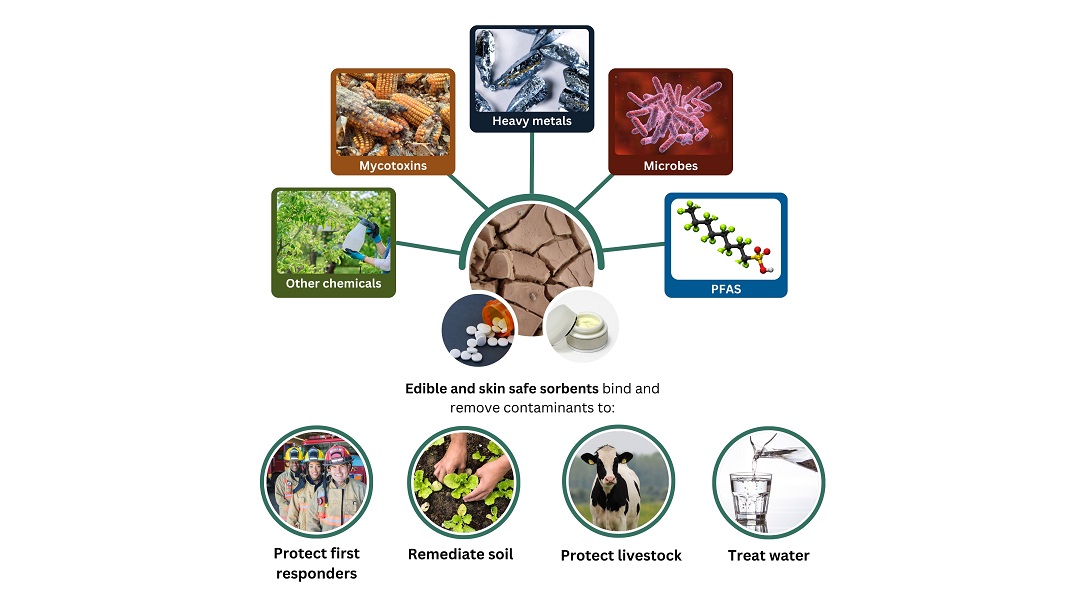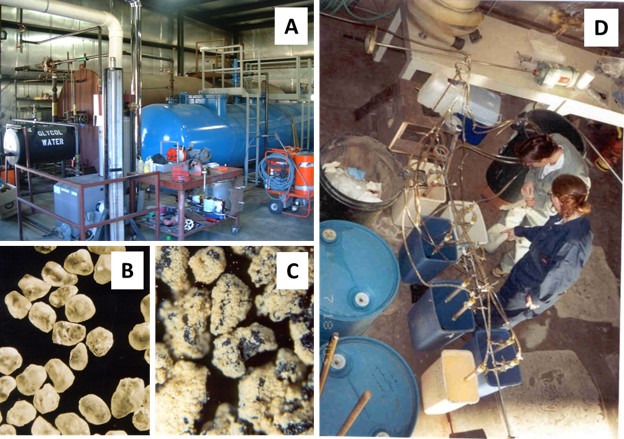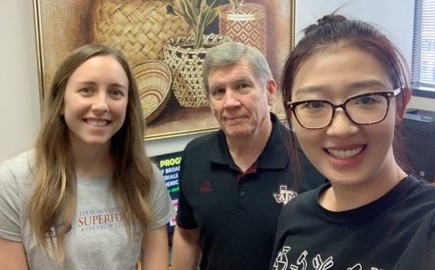Superfund Research Program
By Adeline Lopez
Researchers at the Texas A&M University (TAMU) Superfund Research Program (SRP) Center developed a therapeutic sorbent that can bind to many different hazardous chemicals in the body, reducing the uptake and bioavailability of those chemicals. Built on decades of research, the sorbents, which are pending FDA clearance, can be added to food or water to reduce harmful contaminant exposures.
The sorbent material has also been modified to create a cream that forms a barrier between the skin and harmful chemicals. Usage of both types may follow floods, chemical spills, and other emergencies.

The Problem
In the aftermath of hurricanes and floods, complex mixtures of hazardous chemicals - including polycyclic aromatic hydrocarbons (PAHs), pesticides, polychlorinated biphenyls (PCBs), plasticizers, per- and polyfluoroalkyl substances (PFAS), solvents, and toxic metals - can contaminate drinking water and food supplies. Similarly, during severe droughts, toxic and carcinogenic aflatoxins produced by fungi can contaminate crops.
These chemicals and toxins can result in serious health effects for first responders, cleanup crews, and people and animals living nearby.
SRP Solutions
Timothy Phillips, Ph.D., leads a project developing and testing broad-acting sorbent materials to more effectively bind an array of hazardous chemicals. These new sorbent materials build on more than 30 years of sustained work by Phillips and his research team.
Sorbents are insoluble materials, or mixtures of materials, that may be used to bind and remove contaminants from water or food. The ingestible version, called enterosorbents, can be used to remove toxins from the human gut, while barrier creams can block toxic compounds from penetrating the skin.
Moving Technologies Out of the Lab
- Conducted fundamental research to develop sorbent materials.
- Refined materials to improve binding.
- Demonstrated effectiveness in lab and field tests.
Phillips' early SRP-funded work revealed how hazardous chemicals behave on the surfaces of diverse materials. Building on this early insight and using molecular modeling techniques, his team studied and designed highly functionalized sorbents to bind to and detoxify hazardous compounds in the environment.
To develop sorbents for a specific target chemical, the researchers characterized how the chemical binds to surfaces of various materials, like clay, and defined the structural and functional characteristics that maximized the sorption process. They identified the combinations of modified clay, bonding agent, and substrate needed for optimal performance.
Their sorbent materials were first tested in the lab, followed by scaled-up field studies to evaluate their effectiveness at removing target chemicals from an oil and water separator at a Superfund site in Montana.

An oil and water separator at a Superfund cleanup site in Montana was used to test the effectiveness of clays for PAH removal (A). A close-up view and novel sorbents (B and C) with high capacity and high affinity for chlorophenols and PAHs. When these sorbents were packed in cleanup columns (D), they allowed good hydraulic conductivity and reduced the level of toxins in the filtered water (D).
(Photos courtesy of Tim Phillips)
In field tests, the team reduced the concentration of diverse PAHs, including benzo[a]pyrene, using clay-based sorbents. They also continued their work with highly functionalized clays to develop broad-acting sorbents to reduce exposure to harmful contaminants in food and water, including microbes, mycotoxins such as aflatoxin and zearalenone, heavy metals such as arsenic and lead, pesticides, PCBs, and PAHs.
TAMU SRP Center researchers also developed hydrogel sorbents to remove long- and short-chain PFAS, including one called GenX, within a matter of hours. The sorbents are reusable and readily regenerated.
Testing and Validating Tools to Reduce Exposure
- Transitioned to biomedical applications.
- Developed enterosorbents for inclusion in the diet to reduce toxin exposures in the body and adverse health effects.
- Conducted clinical trials to demonstrate safety and effectiveness.

Leveraging this foundation of research, Phillips shifted his attention to biomedical applications and began developing novel toxin enterosorbents to treat farm animals during contamination outbreaks and emergencies.
The enterosorbents are made of nutrient-enriched clays that research shows are safe for consumption. They tightly bind complex mixtures of hazardous chemicals in the intestines, thereby decreasing chemical exposures and reducing the likelihood of harm to health.
Phillips was the first researcher to use processed clay in animal feed to bind aflatoxin, reduce exposure, and protect against adverse health effects in animals. His research included determining that the materials were safe for animals to eat and did not diminish milk quality and yield.
After determining safety of the active material for human consumption, they began testing its effectiveness in human clinical trials in Texas, Ghana, and Kenya and demonstrated that the enterosorbent materials were effective in reducing biomarkers of aflatoxin exposure in urine and blood samples. Based on this work, a therapeutic clay has been developed for detoxification purposes in people.
Commercializing Useful Tools and Products
- Launched two small businesses.
- Commercialization through worldwide exclusive license.
The enterosorbent technology developed by Phillips and colleagues launched two small businesses: Texas Enterosorbents, Inc. in 2006 and Salient Pharmaceuticals in 2007. Products based on the research are commercially available.
Their aflatoxin enterosorbent for animals was patented, produced, and sold by BASF. Based on Phillips' work, a commercial therapeutic clay is currently available online from Premiere Research Labs.

Phillips and SRP trainees Sara Hearon, left, and Meichen Wang, right, have worked on sorbent materials that can be added to water and soil to reduce exposure to harmful chemicals.
(Photo courtesy of Tim Phillips)
The team also developed broad-acting enterosorbent materials that can be added to food and water to reduce exposure to harmful mixtures of contaminants following natural disasters and other emergencies. They demonstrated that these enterosorbent materials can significantly decrease the toxicity of harmful contaminants and mixtures in lab studies using living organisms with very low tolerance for hazardous substances, such as Hydra vulgaris, Lemna minor, and Caenorhabditis elegans.
Texas EnteroSorbents, Inc. has been granted a worldwide exclusive license through TAMU for further testing and commercialization of this new technology, which would be delivered to first responders and vulnerable populations through food, vitamins, snacks, tablets, or drinking water during emergencies and natural disasters to reduce the toxicity of harmful contaminants and to protect human and animal health.
Innovation in Contaminant Protection
- Tackling PFAS and other contaminants inside the body.
- Barrier creams to protect the skin.
- Back to the soil.
The team has demonstrated that enterosorbents can be tailored to successfully bind diverse contaminants, including harmful algal toxins, pesticides, metals and PFAS and can decrease their toxicity in laboratory studies. For example, adding the common nutrients carnitine or choline enhanced the trapping of PFAS even under simulated digestion conditions and protected against toxicity in lab experiments.
Recently evolving from the clay sorbent concept, the team developed a skin cream to protect people from toxic contaminants in floodwaters. They continue to work with collaborators in industry to refine the formulations that will block different toxins from penetrating the skin and provide UV protection and antibacterial properties. work with collaborators in industry to refine formulations that will block polar and nonpolar toxins from penetrating the skin and will provide UV protection and antibacterial properties.
The team is also harkening back to Phillips’ environmental applications for modified clays and exploring how they can sequester PFAS in soil and reduce their toxicity as well as decrease uptake of PFAS in the soil by plants.


